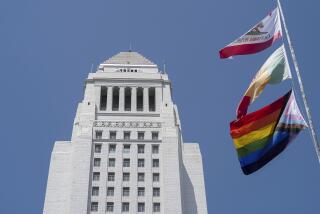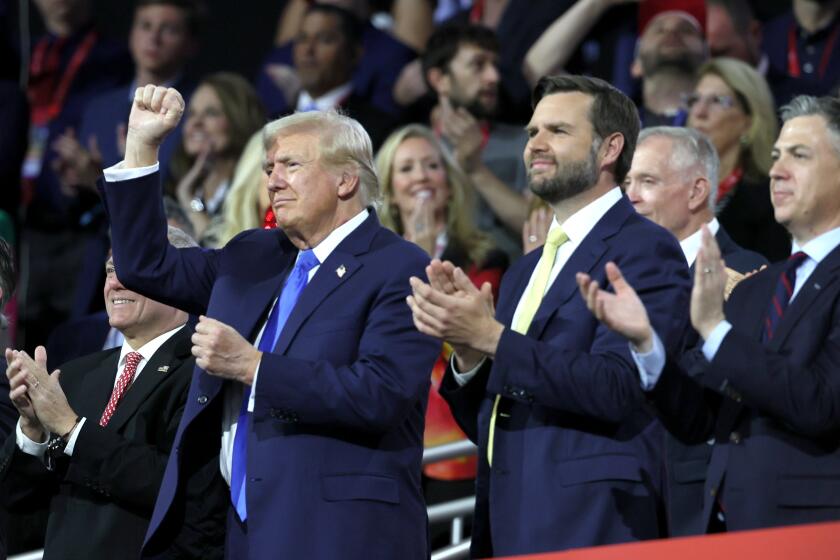Where Life Moves to Latin Beat
Jaime Sanchez was only 17 years old when he left Jalisco, Mexico, to join his older brothers in Huntington Park. He washed dishes when he first arrived, then completed his education and eventually became a real estate agent.
At 43, Sanchez has had plenty of opportunities to move from Huntington Park. But he has stayed. “Living here, it feels just like I am in Mexico,” he said. “Everywhere you go, they speak Spanish and serve Mexican food.”
The population of Huntington Park, five miles southeast of downtown Los Angeles, is about 96% Latino. The city, surrounded by Vernon, Maywood, Bell, Cudahy, South Gate and Walnut Park, has one of the highest residential densities in Southern California. The official population is 58,000 but city officials estimate that about 75,000 people live in Huntington Park, counting undocumented residents.
Huntington Park is also the home of the Pacific Boulevard shopping district, one of the most vibrant Latino marketplaces in Southern California.
Sanchez bought his first home, with two bedrooms and a bath, in the early 1980s for $65,000. He and his wife, Doris, a homemaker, purchased their current home in 1989 for $129,000. It has two bedrooms, with a bonus room that the family uses as a third bedroom, and 1 1/2 baths in 1,200 square feet.
“I can’t imagine living anywhere else,” Sanchez said. “I wouldn’t be comfortable outside my own community.”
Huntington Park draws many first-generation immigrants like Sanchez, and close to 75% of its residents are renters, most living in single-family homes since there are relatively few apartments in the city.
Two- and three-bedroom California bungalows and Craftsman-style homes with less than 1,000 square feet and dating from the 1920s and ‘30s sell for an average of $130,000. Newer homes, built in the last decade, are typically three- and four-bedroom two-story houses from 1,500 to 1,900 square feet and sell for $150,000 to $170,000.
The city’s main thoroughfare and thriving shopping district, Pacific Boulevard, is five blocks long and provides more than half a mile of shopping that draws customers from as far away as Northridge and Santa Ana.
More than 600 merchants are situated on Pacific Boulevard, mostly independent stores catering to Latinos but including such national retailers as JCPenney, Petries, Thrifty and Miller’s Outpost.
The crime rate along the boulevard--from shoplifting to car burglary--has decreased, thanks to police bicycle patrols and a storefront substation established recently, said Police Chief Randy Narramore, who was hired in April 1995 to revamp the department. Narramore has implemented several innovative programs to help fight the gang violence and crime that plagues the city. Residents are feeling the improvements. “I feel safe here,” said Rosie Olguin, 32, an office assistant who has lived in Huntington Park since April 1988. She purchased a two-story home built in the northeast part of the city in the mid-1980s for $157,500, getting three bedrooms, 2 1/2 baths, a family room, a dining room and a two-car garage.
“The police cars are always around keeping an eye on things, the schools are pretty good and the shopping areas and freeways are really close by,” she said.
The proximity of Huntington Park to downtown Los Angeles played a large part in its incorporation back in 1906. It started out as an exclusive residential enclave called Le Park, removed from the dirt and noise of downtown but close enough to get there by horse and buggy.
The city boomed in the 1920s, when Henry Huntington brought his railroad through the center of town and got the town named for himself. Over the next five decades, Huntington Park remained a fairly exclusive city. Its population has shifted to majority Latino during the last 15 years, with 3% non-Latino white residents and only a handful of African American and Asian American residents.
Manuel V. Avila, a social worker, and his wife, Becky, a preschool teacher, have experienced the demographic shift first-hand since they moved to Huntington Park in the early 1970s and purchased a three-bedroom 1 1/2-bath home for $21,500.
“For us, it’s a nice place to live because we are close to downtown, to the airport, to the beaches at Long Beach and San Pedro, to Orange County and Disneyland. The community is strategically located, right in the middle of where the action is,” Avila said.
The family purchased a larger home in 1987, paying $150,000 for four bedrooms, two baths, a den and a study and adding a swimming pool.
Tom Jackson, 59, who has been on the City Council for 27 years and has served as Huntington Park’s mayor nine times, remembers decades ago when Pacific Boulevard was a high-end regional shopping area featuring car dealerships, exclusive clothing shops and boutiques. Jackson has owned a florist shop in Huntington Park since 1970.
During the early 1960s, as air-conditioned indoor malls began to dominate the retail shopping market and more people moved into distant suburbs, Pacific Boulevard’s stores closed, vacancies accumulated and shoppers stopped making Huntington Park their weekend destination.
“We had a decline of business on the boulevard in the early ‘60s,” says Jackson.
“By the mid-60s and into the ‘70s, business on the boulevard was going downhill rapidly. I was elected in 1968 and there were 65 vacant stores out of 400 total. Then, as more Latino residents began moving into Huntington Park in the late ‘70s and early ‘80s, vacant storefronts were bought up and a revitalized shopping district, this time catering to Latinos, was born.
“During the past 10 years, the boulevard has been thriving. We pay our bills in the city mostly from the sales tax revenue that’s generated by those merchants.”
That retail tax revenue amounts to more than $1 million annually from Pacific Boulevard merchants alone, according to Jack Wong, the city’s community development director.
The city’s general plan was amended in 1990 to meet the growing need for affordable housing by increasing density levels, Wong said. Currently, the development of several affordable housing projects is underway in the city and the redevelopment agency is considering allowing single-room-occupancy dwellings in the now-vacant second, third and fourth stories of Pacific Boulevard storefronts.
One recently completed project, with 103 affordable rental units, will include an on-site tutoring program for resident children. The provision of after-school tutoring is welcomed by education officials in Huntington Park, since schools in the city are crowded and often strained by high percentages of non-English-speaking students.
A part of the Los Angeles Unified School District, Huntington Park is home to a dozen elementary schools, a middle school and a high school. Miles Avenue school is the nation’s largest elementary school and has 2,700 preschool to fifth-graders enrolled in three year-round educational tracks.
“We are a typical inner-city school, with overcrowded conditions, many students from single-parent homes, 64% in bilingual classrooms and 92% qualifying for free or reduced-cost lunch programs,” said Jose Velazquez, the school’s principal for the last three years.
While statewide test scores show 38% of Miles Avenue’s students score in the lowest academic group, Velazquez said scores have been improving over the last several years. He also said his school has recently implemented a strategic plan to improve instruction.
Miles Avenue includes a math-technology bilingual magnet school on its campus and also houses a parent center and a child-care center and offers English classes to parents and community members.
Schools are one thing that Huntington Park residents Jesus and Linda Lopez, who moved from Bell in 1994, will have to start thinking about soon.
“We came to a wedding reception a couple houses down from where we live now and happened to see the ‘For Sale’ sign,” Linda Lopez said. The couple owned the trailer they lived in but when they found out they were expecting twin girls, they knew they would need more room. “My husband does a lot of remodeling and he knew he could do something with the house.”
They purchased the property--a duplex--for $135,000 and they rent out the attached second unit. “We have a living room, a kitchen, one bedroom and a bathroom,” Lopez said. “My husband turned the laundry room into a second bedroom. We have a backyard with orange trees, avocados and room for a garden.”
Best of all, Huntington Park’s location is still right. The house is not far from Jesus’ manufacturing job and from her part-time work at a local pharmacy. “It’s so close to work that we can be home with the kids a lot,” she said.
(BEGIN TEXT OF INFOBOX / INFOGRAPHIC)
Huntington Park Home Sale Data
*--*
Sample Size (for 10-year period) 1,104 Ave. home size (square feet) 1,173 Ave. year built 1933 Ave. No. Bedrms 2.46 Ave. No. Baths 1.34 Pool 2% Central air 5% Floodzone 35% Price Range (1995-96) $59,000-210,000 Predominant Value $121,000 Age Range 5-94 years Predominant Age 65 years
*--*
Average Sales Data
*--*
Year Total Sales $ per sq. ft. Median price 1996* 18 $137.45 $142,388 1995 82 $114.31 $148,707 1994 91 $123.81 $146,032 1993 56 $136.49 $160,928 1992 82 $141.17 $166,975 1991 107 $138.24 $169,663 1990 160 $139.91 $169,465 1989 159 $133.89 $145,484 1988 197 $102.95 $123,189 1987 152 $91.49 $104,368
*--*
*1996 data current through March.
Source: TRW Redi Property Data, Anaheim
More to Read
Start your day right
Sign up for Essential California for news, features and recommendations from the L.A. Times and beyond in your inbox six days a week.
You may occasionally receive promotional content from the Los Angeles Times.






